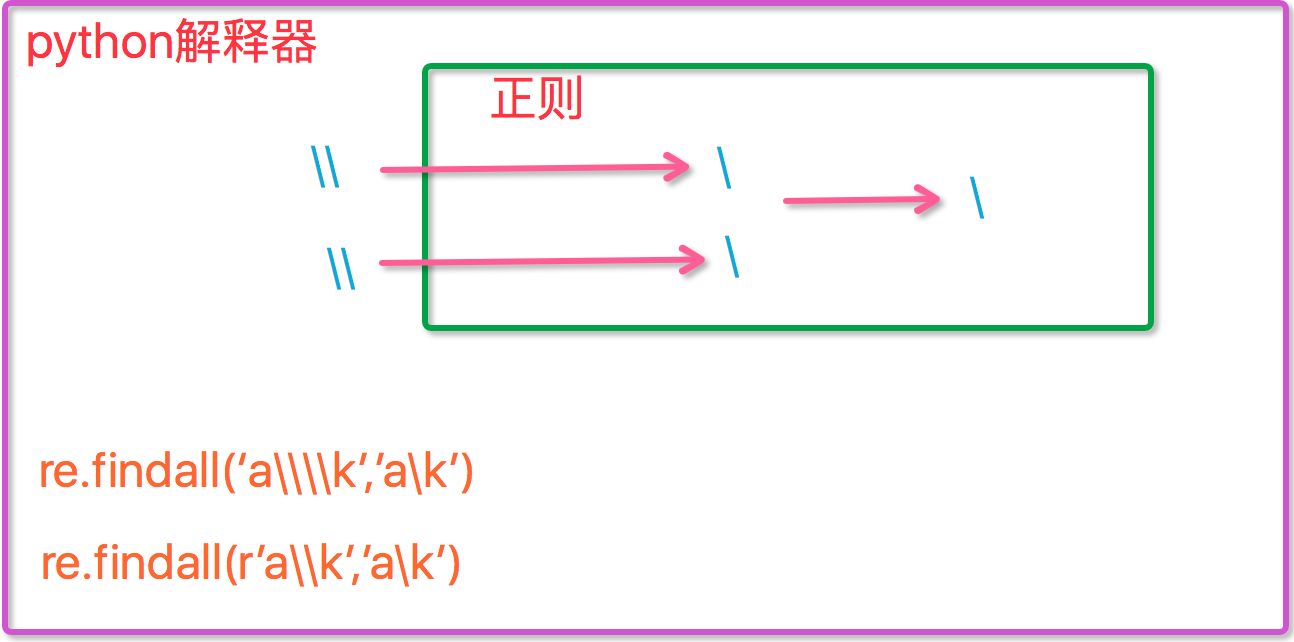Python正則RE
阿新 • • 發佈:2017-10-04
asc repl 分割 貪婪 不包含 字符 十進制數 .cn wwwn
就其本質而言,正則表達式(或 RE)是一種小型的、高度專業化的編程語言,(在Python中)它內嵌在Python中,並通過 re 模塊實現。正則表達式模式被編譯成一系列的字節碼,然後由用 C 編寫的匹配引擎執行。
RE字符:
元字符:. ^ $ * + ? { } [ ] | ( ) \
普通字符:字母數字
1 import re 2 3 ret=re.findall(‘a..in‘,‘helloalvin‘) #.匹配一個字符 4 print(ret)#[‘alvin‘] 5 6 7 ret=re.findall(‘^a...n‘,‘alvinhelloawwwn‘) #^從開頭匹配 8 print(ret)#[‘alvin‘] 9 10 11 ret=re.findall(‘a...n$‘,‘alvinhelloawwwn‘)#$從末尾匹配 12 print(ret)#[‘awwwn‘] 13 14 15 ret=re.findall(‘a...n$‘,‘alvinhelloawwwn‘) 16 print(ret)#[‘awwwn‘] 17 18 19 ret=re.findall(‘abc*‘,‘abcccc‘)#貪婪匹配[0,+oo] *前面的字母有0個或者多個 20 print(ret)#[‘abcccc‘] 21 22ret=re.findall(‘abc+‘,‘abccc‘)#[1,+oo] +前面的字母有0個或者多個 23 print(ret)#[‘abccc‘] 24 25 ret=re.findall(‘abc?‘,‘abccc‘)#[0,1] ?前面的字母1個或者0個 26 print(ret)#[‘abc‘] 27 28 29 ret=re.findall(‘abc{1,4}‘,‘abccc‘) 30 print(ret)#[‘abccc‘] 貪婪匹配
註意:前面的*,+,?等都是貪婪匹配,也就是盡可能匹配,後面加?號使其變成惰性匹配
ret=re.findall(‘qta*?‘,‘qtaaaasd‘) print(ret) #[‘qt‘]
元字符之字符集[]:
ret=re.findall(‘a[bc]d‘,‘abdacd‘) print(ret) #[‘abd‘, ‘acd‘]
ret=re.findall(‘a[a-z]d‘,‘abdacd‘)
print(ret) #[‘abd‘, ‘acd‘]
ret=re.findall(‘[.*,]‘,‘ab,da.c*d‘)
print(ret)#[‘,‘, ‘.‘, ‘*‘]
ret=re.findall(‘[^.*,]‘,‘ab,da.c*d‘) #不包含字符集內的元素
print(ret) # [‘a‘, ‘b‘, ‘d‘, ‘a‘, ‘c‘, ‘d‘]
ret=re.findall(‘[\d]‘,‘ab,da.c*d123‘) #\d匹配任何數字 和[1-9]一樣
print(ret) #[‘1‘, ‘2‘, ‘3‘]
ret=re.findall(‘[\D]‘,‘ab,da.c*d123‘) #\D匹配所有不是數字的字符
print(ret)# [‘a‘, ‘b‘, ‘,‘, ‘d‘, ‘a‘, ‘.‘, ‘c‘, ‘*‘, ‘d‘]
ret=re.findall(‘[\w]‘,‘ab,da.c*d123‘)#\w匹配任何數字和字符類似[1-9a-zA-Z]
print(ret) #[‘a‘, ‘b‘, ‘d‘, ‘a‘, ‘c‘, ‘d‘, ‘1‘, ‘2‘, ‘3‘]
ret=re.findall(‘[\W]‘,‘ab,da.c*d123‘) #\W匹配任何不是數字和字符的
print(ret) #[‘,‘, ‘.‘, ‘*‘]
ret=re.findall(‘[\s]‘,‘ab,da.c*d123\t\n‘) #\s匹配任何空白字符
print(ret) #[‘\t‘, ‘\n‘]
ret=re.findall(‘[\S]‘,‘ab,da.c*d123\t\n‘) #\S匹配任何不是空白字符
print(ret) #[‘a‘, ‘b‘, ‘,‘, ‘d‘, ‘a‘, ‘.‘, ‘c‘, ‘*‘, ‘d‘, ‘1‘, ‘2‘, ‘3‘]
元字符之轉義符\
反斜杠後邊跟元字符去除特殊功能,比如\.
反斜杠後邊跟普通字符實現特殊功能,比如\d
\d 匹配任何十進制數;它相當於類 [0-9]。
\D 匹配任何非數字字符;它相當於類 [^0-9]。
\s 匹配任何空白字符;它相當於類 [ \t\n\r\f\v]。
\S 匹配任何非空白字符;它相當於類 [^ \t\n\r\f\v]。
\w 匹配任何字母數字字符;它相當於類 [a-zA-Z0-9_]。
\W 匹配任何非字母數字字符;它相當於類 [^a-zA-Z0-9_]
\b 匹配一個特殊字符邊界,比如空格 ,&,#等
現在我們聊一聊\,先看下面兩個匹配:
1 #-----------------------------eg1: 2 import re 3 ret=re.findall(‘c\l‘,‘abc\le‘) 4 print(ret)#[] 5 ret=re.findall(‘c\\l‘,‘abc\le‘) 6 print(ret)#[] 7 ret=re.findall(‘c\\\\l‘,‘abc\le‘) 8 print(ret)#[‘c\\l‘] 9 ret=re.findall(r‘c\\l‘,‘abc\le‘) 10 print(ret)#[‘c\\l‘] r說明再python用原生字符串 11 12 #-----------------------------eg2: 13 #之所以選擇\b是因為\b在ASCII表中是有意義的 14 m = re.findall(‘\bblow‘, ‘blow‘) 15 print(m) 16 m = re.findall(r‘\bblow‘, ‘blow‘) 17 print(m)

元字符之分組()
1 m = re.findall(‘(bl)‘, ‘blow‘) #整體匹配‘bl’ 2 print(m) #[‘bl‘]
元字符之|
ret=re.search(‘(ab)|\d‘,‘rabhdg8sd‘) #或,從左開始匹配,如果有匹配出來,如果沒有匹配右邊的 print(ret.group())#ab
RE的五種基本操做
re.match(pattern, string) # 從頭匹配 re.search(pattern, string) # 匹配整個字符串,直到找到一個匹配 re.split() # 將匹配到的格式當做分割點對字符串分割成列表 >>>m = re.split("[0-9]", "alex1rain2jack3helen rachel8") >>>print(m) 輸出: [‘alex‘, ‘rain‘, ‘jack‘, ‘helen rachel‘, ‘‘] re.findall() # 找到所有要匹配的字符並返回列表格式 >>>m = re.findall("[0-9]", "alex1rain2jack3helen rachel8") >>>print(m)<br> 輸出:[‘1‘, ‘2‘, ‘3‘, ‘8‘] re.sub(pattern, repl, string, count,flag) # 替換匹配到的字符 m=re.sub("[0-9]","|", "alex1rain2jack3helen rachel8",count=2 ) print(m) 輸出:alex|rain|jack3helen rachel8
Python正則RE
